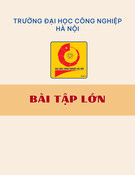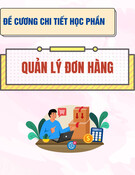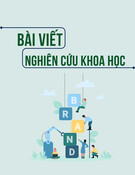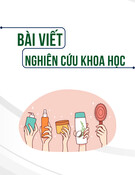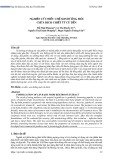
ECONOMICS - SOCIETY https://jst-haui.vn HaUI Journal of Science and Technology Vol. 60 - No. 11E (Nov 2024)
28
P
-
ISSN 1859
-
3585
E
-
ISSN 2615
-
961
9
RESEARCHING THE MEDIATING ROLE OF CIRCULAR FASHION AWARENESS IN VIETNAMESE CONSUMERS' INTENTION TO PURCHASE SECONDHAND CLOTHES
Bui Thi Phuong Hoa1,* DOI: http://doi.org/10.57001/huih5804.2024.340 ABSTRACT
This study focuses on understanding the factors that inuence
Vietnamese consumers' intention to buy secondhand clothes, especially
understanding the mediating role of
circular fashion awareness. Use
quantitative research methods. With the sample size of 823. Data processed by
SPSS 22 and AMOSS 22 software. The study has shown that the factors of
awareness of circular fashion, uniqueness, price, and store image are
inu
ential on consumers' intention to buy SHC. Especially the mediating role
of circular fashion awareness. At the same time, it also shows that social
communication indirectly affects purchasing intention through awareness.
There are differences in gender and income but no difference in age. Keywords
: Circular fashion, secondhand clothes, circular fashion awareness,
uniqueness, store image, social communication, purchase intention, price. 1Hanoi University of Industry, Vietnam *Email: hoabtp@haui.edu.vn Received: 17/5/2024 Revised: 25/7/2024 Accepted: 28/11/2024 1. INTRODUCTION How to reduce the amount of fashion waste into the environment is one of the issues of concern to many countries, scientists, businesses and consumers. Circular fashion (CF) is a model that keeps fashion products in use for as long as possible towards minimizing fashion waste into the environment. The CF model will reuse old items to extend the life of the product, both helping to protect the environment and bringing high economic value. Products will be focused right from the design stage and choosing raw materials at the beginning. All materials also ensure that the product can be reused for as long as possible. Buying secondhand clothes (SHC) instead of buying new clothes is considered one of the most effective circular economy practices [1] because reusing clothes helps prolongs the life cycle of clothing, reduces the amount of clothing thrown away in landfills, thereby reducing environmental pollution and waste of resources [2]. However, in Vietnam, SHC is seen as low-end fashion for poor people. Therefore, to convince Vietnamese consumers that SHC is a way of practicing circular fashion consumption is a difficult problem. At the same time, there is not much research on second-hand fashion in Vietnam, especially in considering used shopping as a measure of circular economy. Therefore, it is necessary to conduct research on consumer opinions about SHC in Vietnam. To shift from a linear economy with a focus on make-dispose to a circular economy aimed at creating endless cycles of resources, with one industry's waste being the input of another, requires effort of both government and business and ultimately, consumer acceptance and action [3-6]. In particular, learning about consumers' acceptance of product use is an important aspect, because only by receiving consumers' acceptance of purchase and use can successful conversion be possible. This study was conducted with 3 research questions: First: What factors affect consumers' intention to buy SHC? Second: How will consumers' awareness of circular fashion inuence their intentions? Third: Are there differences between different consumers in their perceptions and purchase intentions? 2. THEORETICAL BASIS AND RESEARCH MODEL 2.1. Price Interest in the circular economy and environmental sustainability in general is growing. However, consumers'















